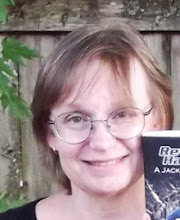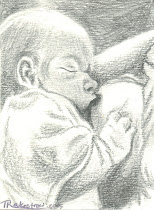I came across this on Facebook. I got permission from Paul to share it. I think it is important to know the difference between nudity and pornography. Heck, I have an old disposable camera I can never get developed because there are birth pictures on it, and I was flat out told at the film counter at Walmart that if there was nudity, they would keep it and report it. Ask yourself... how far is too far? If we can't document the births of our children the way we want... if we can't record those precious moments when little Penny or Georgie strip down outside and step in the wading pool because it is one of those moments that we all treasure as parents... how far does it go?
YouTube has already removed many of the birth videos that have been posted. Facebook has the big controversy over breastfeeding photos. How far will we let it go?
Paul Rapoport, National Post
Published: Tuesday, May 19, 2009
Last July in this newspaper, I described what I now call Acts I and II of a sorry controversy in Australia. It raged over photographs of naked minors by Bill Henson and Polixeni Papapetrou, both well-known artists. Photos that had been exhibited with no problems before were now claimed to exemplify sexual exploitation, child pornography and the downfall of all children's innocence. Those fears were expressed loudly. The evidence justifying them was absent.
One positive outcome in the controversy was a decision of Australia's Classification Board. Refusing to bow to political demands for censorship, it upheld the suitability of the attacked images.
Nonetheless, the whole drama hammered artists, galleries and publications. In a later act, the Australia Council, a granting agency somewhat like the Canada Council, imposed regulations that stifled all art involving children. Papapetrou explained, "I have to apply for a police check and then get special government permission on each occasion before I make pictures [of children]." And that has nothing to do with nudity.
The council is presuming that artists dealing with nudity of minors are child sexual abusers. With that perverse attitude, we would never have had the American Nick Ut's prize-winning photo (from 1972) of a nine-year-old girl escaping a napalm attack in Vietnam, nor the Canadian Paul Peel's iconic painting (from 1890), After the Bath. Neither Henson nor Papapetrou would have become known internationally.
This issue is hardly confined to Australia. Early this year, upon learning of an American photographic exhibition, one person launched a smear campaign against it wherever it was scheduled to appear.
His target was "The Century Project," by Frank Cordelle, a series of nude photographic portraits of girls and women, with important texts about each. It had been exhibited at universities and colleges in North America for 17 consecutive years, to high praise from psychiatrists, social workers and many others. That has included three successful visits to Canada.
One school ignored the complainer. But his false claim that all photos of female nudity are harmful pornography came in handy to officials elsewhere. For its exhibition at one university in March, an administrator banned all The Century Project's photos of girls under 18. Another school moved the project's exhibition to where fewer people would see it. A third cancelled it outright.
This censorship also had its bright side. The administrator who banned the girls' photos was unable to justify his authoritarian decision or cover up his false statements. He was forced to resign. But there was no real joy in this saga either. That people demand extreme censorship based on myths about children and nudity remains a serious problem.
The prime myth is that all photographs of child nudity are illegal. This is no longer in the background but considered a specific "fact." In early April, Ruth Marcus of The Washington Post left no doubt: "Nude photos of minors --- even if the minor is you --- are child pornography."
Not only is there no basis for that absurdity in jurisprudence in North America, it maligns family snapshots as well as photos in the arts, medicine or naturism; and it declares the sole purpose of a lack of clothes to be immoral, harmful sexuality.
Another myth: Sexual predation is an epidemic. Curiously, one major research centre in the U. S. states that between 1992 and 2006, substantiated child sexual abuse there declined by more than 50%. That suggestive detail accompanies the rapid rise of the Internet, with all its assumed dangers.
Repeatedly, researchers have tried to show that photos of nudity increase sex crimes in the general population. All reputable attempts have failed.
Still we make false universal connections between photos and child abuse, when, as the art historian Anne Higonnet points out, the indicators of the latter are often single parenthood, poverty and substance abuse. We encourage sexist beauty pageants that sexualize young girls while we vilify their non-sexualized unclothed portraits in a project with proven therapeutic value. We engage in abstinence-led sex education despite convincing evidence that it doesn't work. How could all this hypocrisy and shallowness produce anything but bad results?
The therapist and writer Marty Klein refers to these myths as propaganda from "the vampires of the sexual disaster industry." The war over bodies and sexuality is indeed an extended horror show. Those producing it may know that controlling bodies by shame and guilt is a powerful mechanism to dominate and manipulate people in many aspects of their lives.
There are implications in all this for the current concern over "sexting" --- teenagers using cellphones to take or transmit electronic images of themselves nude or partly dressed. Notwithstanding problems in this activity irrelevant to photographic exhibitions or publications, we hear the same myths about children. "Pornography!" is the cry here, too, although we rarely get adequate reports of the photos. Many in the media also report as if all child nudity entails catastrophic sexual misconduct.
For sexting, law enforcers in several states have been quick to bring charges of possession of child porn, mostly against female self-photographers. Ostensibly wanting to protect a girl as victim, they make her the perpetrator as well, and threaten her with prison time and sex offender status for decades.
Fortunately, in one recent instance of supposed sexting in Pennsylvania, a prosecutor was stopped from threatening child porn charges against girls who refused to submit to his spiteful corrections program when they had done nothing illegal.
Yet who really wins in all these confrontations? Pertinent is the answer of Robert Nelson, an Australian art critic and historian, and husband of Polixeni Papapetrou: "We are in a most unfortunate predicament where everyone is a loser." That includes children. They are more anxious and insecure about their bodies than ever.
The guise of protecting children that does no such thing may be defeated only by massive re-education about the body and sexuality. We may take heart in those brave artists, educators and others who point out not only our folly but ways to overcome it. We could start by recognizing that groundless fearful imaginings, while understandable, are awfully poor bases for any policy, including censorship.
----
Paul Rapoport is professor emeritus in the School of the Arts at McMaster University in Hamilton, Ont., editor of the magazine Going Natural / Au naturel and a member of the Society for the Scientific Study of Sexuality.
Tuesday, May 19, 2009
Debunking Myths about Child Nudity
Posted by Toni at 10:10 AM 0 comments
Sunday, May 10, 2009
Happy Mother's Day!
Happy Mother's Day! As the year has turned once again to this sunny day in May, I want to thank all the mothers out there. You know who you are. Those unafraid of wiping snotty noses, changing diapers that could double as nuclear waste, and will hold a sick, feverish child close for hours to make them feel better.
We mothers come in all shapes and sizes; from all walks of life. Some of us work outside the home; some work within it; and others spend all their waking hours chasing children and cleaning up after them. Some of us have older children who attend twenty activities a day. Some of us have grown children with babies of their own. Some of us are still awaiting that miraculous change, when that big baby bump transforms magically into a baby in our arms... and the transformation takes a lot of work on our part.
So have a wondrous, marvelous day... take a few moments to look upon your children and marvel at their existence. They have helped make you who you are today. Happy Mother's Day!
Posted by Toni at 11:56 AM 0 comments







